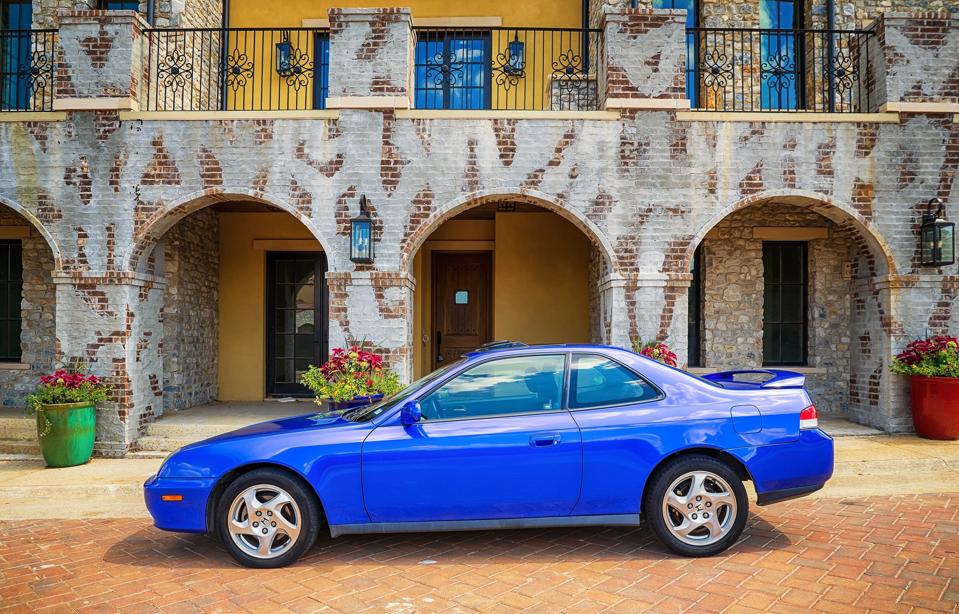Honda announced in December that Prelude is making its highly-anticipated return to the North American market for the 2026 model year, nearly 25 years after its last appearance. Although the new car will proudly wear the “PRELUDE” badge, more than two decades of innovation will make it almost unrecognizable as a direct descendant of the original. To understand how different the all-new model will be when compared to the long-since-discontinued 2001 model, we took a closer look at the chassis, suspension, engine, technology, and pricing.
When it arrived in 1997, the fifth-generation Prelude rode on a modified Honda Accord platform. While the wheelbase was shorter, it shared suspension and braking components with the Accord—double-wishbones at all four corners, and disc brakes with a single sliding caliper inside each wheel (the front rotors were ventilated).
The 2026 Prelude will share a chassis with the Honda Civic—more specifically, the performance-tuned Type R model. It will feature an innovative dual-axis front suspension, paired with a multi-link rear suspension. There are massive two-piece ventilated brake rotors, with four-piston Brembo calipers, on the front axle. The rear axle will be fitted with disc brakes with single-piston calipers.
The 2001 Honda Prelude had 16-inch wheels and 205/55-16 tires—small by today’s standards, even though the SH model had slightly wider wheels. Expect the new Prelude to ride on 19- or 20-inch wheels and have significantly wider tires (keep in mind that the performance-oriented 2025 Honda Civic Type R is fitted with 19-inch wheels and 265/30ZR19 tires).
Under the hood, the 2001 Prelude featured a standard naturally aspirated 2.2-liter four-cylinder (H22A4 VTEC engine), rated at 200 horsepower and 156 lb-ft of torque, which sent all the power to the front wheels. A 5-speed manual gearbox was standard, but customers could also opt for a 4-speed automatic transmission. The 0-60 mph time was 7.2 seconds with the manual transmission, but it increased to 8.2 seconds with the torque converter automatic.
It’s an entirely different story with the 2026 Honda Prelude, which has an advanced hybrid powertrain combining an Atkinson-cycle 2.0-liter four-cylinder engine paired with Honda’s e:HEV dual-motor hybrid system—one motor for propulsion, and a second for electricity generation (the Prelude won’t have a turbocharged engine like the Civic Type R). Power estimates are 200 horsepower and 285 lb-ft for torque. While it retains a front-wheel drive powertrain, the standard transmission is the Honda S+ Shift system—an innovative gear shift simulation system with a sporty S+ Shift drive mode. It will be much quicker than its predecessor—expect the 0-60 mph time to be in a brisk 6 seconds (this rate of acceleration positions the new Prelude favorably against its two primary rivals, the Toyota GR86 and Mazda MX-5 Miata).
There was no “infotainment” option on the last-year 2001 Honda Prelude. Instead, it was equipped with a standard AM/FM stereo, CD player, and six speakers. While it did feature Honda’s Acoustic Feedback Sound System (AFB), the only driver interface was a one-line monochromatic LCD.
Expect the all-new Prelude to arrive with a robust infotainment system, featuring at least a 9-inch touchscreen, a 12-speaker Bose premium sound system, SiriusXM satellite radio, wireless Apple CarPlay and Android Auto compatibility, Bluetooth, and HondaLink connected services for remote vehicle access and information.
In terms of pricing, the Prelude has always been one of Honda’s premium products. In 2001, the last year it was sold in the United States, the base price (MSRP) of the base Honda Prelude was approximately $24,040 (the higher trim, the Prelude SH, started around $26,540). Honda has not released pricing for the new model, but most experts believe it will have a base price between $31,000 and $38,000—I’d wager towards the more expensive pricing, especially for a premium trim.
In short, the all-new 2026 Honda Prelude will be larger, more comfortable, more powerful, more fuel-efficient, and equipped with far more advanced technology than its predecessor—making it a great value, even with a $10,000 price increase after 25 years.

